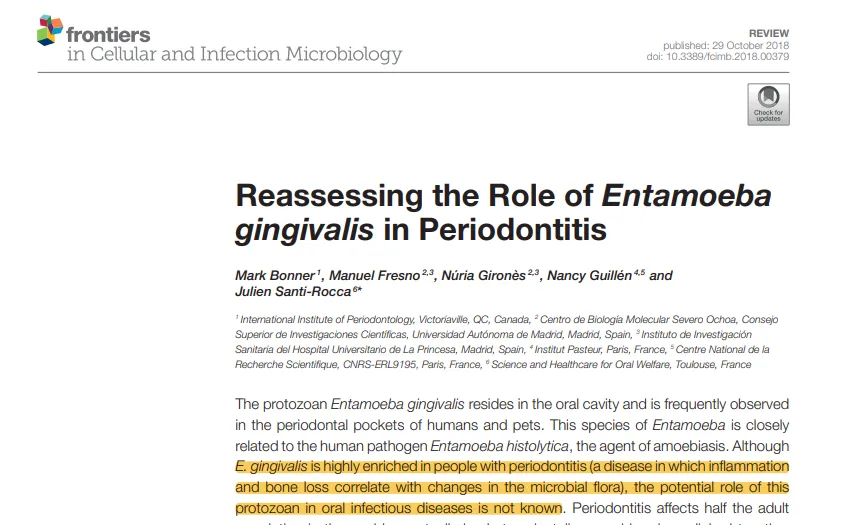Blog

Reassessing The Role of Entamoeba Gingivalis In Periodontitis
Reassessing the Role of Entamoeba gingivalis in Periodontitis
Mark Bonner 1 , Manuel Fresno2,3, Núria Gironès 2,3, Nancy Guillén4,5 and Julien Santi-Rocca6
* 1 International Institute of Periodontology, Victoriaville, QC, Canada, 2 Centro de Biología Molecular Severo Ochoa, Consejo Superior de Investigaciones Científicas, Universidad Autónoma de Madrid, Madrid, Spain, 3 Instituto de Investigación Sanitaria del Hospital Universitario de La Princesa, Madrid, Spain, 4 Institut Pasteur, Paris, France, 5 Centre National de la Recherche Scientifique, CNRS-ERL9195, Paris, France, 6 Science and Healthcare for Oral Welfare, Toulouse, France
The protozoan Entamoeba gingivalis resides in the oral cavity and is frequently observed in the periodontal pockets of humans and pets. This species of Entamoeba is closely related to the human pathogen Entamoeba histolytica, the agent of amoebiasis. Although E. gingivalis is highly enriched in people with periodontitis (a disease in which inflammation and bone loss correlate with changes in the microbial flora), the potential role of this protozoan in oral infectious diseases is not known. Periodontitis affects half the adult population in the world, eventually leads to edentulism, and has been linked to other pathologies, like diabetes and cardiovascular diseases. As aging is a risk factor for the disorder, it is considered an inevitable physiological process, even though it can be prevented and cured. However, the impact of periodontitis on the patient’s health and quality of life, as well as its economic burden, are underestimated. Commonly accepted models explain the progression from health to gingivitis and then periodontitis by a gradual change in the identity and proportion of bacterial microorganisms in the gingival crevices. Though not pathognomonic, inflammation is always present in periodontitis. The recruitment of leukocytes to inflamed gums and their passage to the periodontal pocket lumen are speculated to fuel both tissue destruction and the development of the flora. The individual contribution to the disease of each bacterial species is difficult to establish and the eventual role of protozoa in the fate of this disease has been ignored. Following recent scientific findings, we discuss the relevance of these data and propose that the status of E. gingivalis be reconsidered as a potential pathogen contributing to periodontitis.
Keywords: Entamoeba gingivalis, periodontitis, gingivitis, inflammation, parasitic infection, infectious disease.
Contact Us
+61 404 039 649
